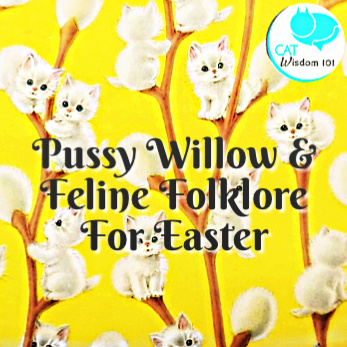
Pussy Willow & Feline Folklore For Easter
Pussy Willow and Feline Folklore For Easter
Scroll down to the end for our Easter greetings. I’ve edited a selection of vintage Easter pussy willow and cat art to accent the folklore.

The distinctive fuzzy gray catkins of the pussy willow tree, resembling cat tails, have long been steeped in folklore across Europe and the ancient world, symbolically linking the plant to the mystical essence, fertility, and spirit embodied by our feline companions.
Native American Legends
For tribes like the Abenaki, Mohawk, and others in the Northeast woodlands, there are myths that pussy willows grew from the ashes or remains of cats that were killed, often by fire. One Cherokee legend tells of starving settlers burning their cats, with the soft catkins sprouting from the ashes and scattered fur.
Another Abenaki story describes a mother cat saving her kittens from a burning longhouse. Though she survives, her scorched fur falls off her body onto willow branches outside, forming the first pussy willow buds in the spring. These indigenous legends connect the birth of pussy willows to the sacrifice or death of cats.
Another legend speaks of the paws of frozen kittens that wandered into willow groves and died during harsh winters. Their remains transformed into the furry catkins on the willow branches as spring arrived.
Appalachian Superstitions
In Appalachian folk traditions, some believed that ghostly cats haunted willow thickets at night, leaving paw print impressions in the soft mud and bark that turned into pussy willow buds come morning. Others claimed the delicate blooms sprouted along paths where cats dragged their tails through the dirt under willow tr
Across these diverse cultural traditions, the soft, fur-like texture of the pussy willow invites comparisons to cats through imaginative myths explaining the plant’s annual emergence, embodying spring’s renewal through its connection to domesticated felines.
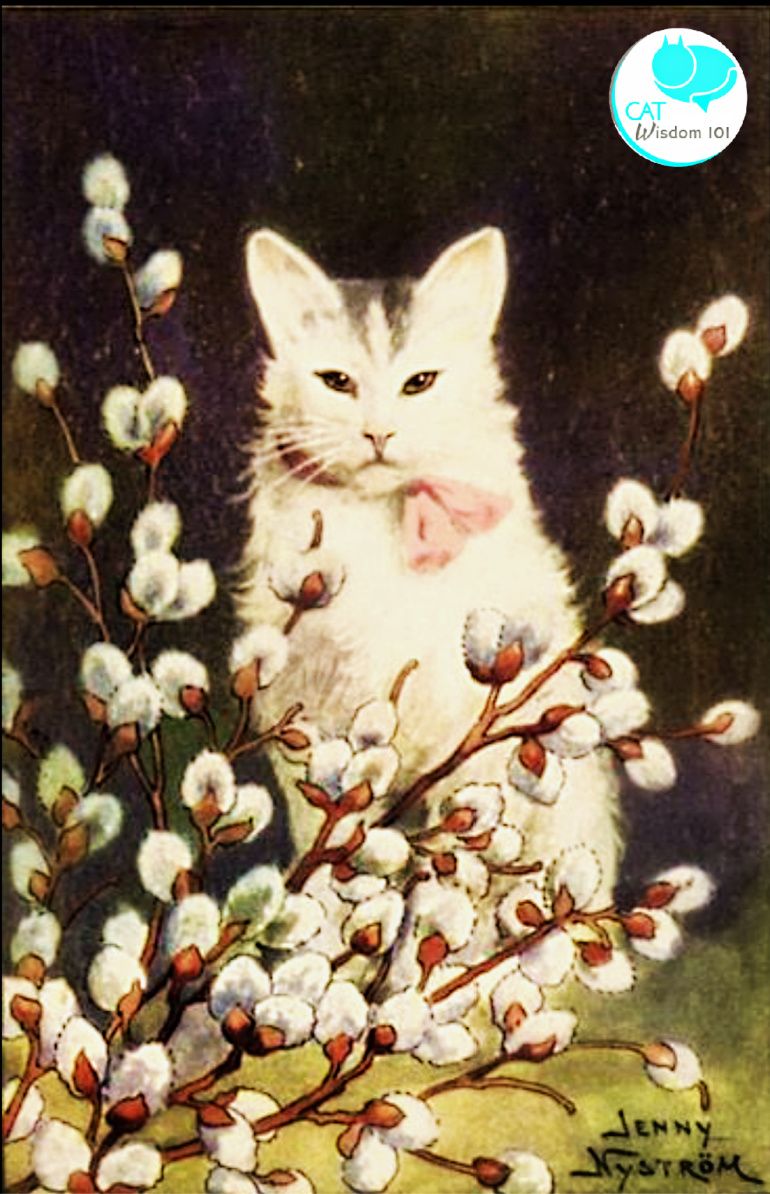
Ancient Greek and Roman Beliefs:
In ancient Greece, the willow tree was sacred to several important deities who were commonly depicted alongside feline companions or symbols:
Persephone – As the goddess of fertility and spring, Persephone was closely linked to willow branches budding new growth each year. Her return from the underworld was heralded by blooming willows. Cats were one of Persephone’s symbolic animals representing rebirth.
Hecate– This goddess of witchcraft, magic and keeper of household familiars, was typically portrayed holding a willow branch and accompanied by a cat. Willow was used in spells and rituals of her cult followers.
Artemis/Diana – The Roman and Greek virgin huntress goddesses were associated with willow groves and fringes. As “defiant” goddesses, they were allied with the fierce hunting skills of cats. Additionally, the shape of willow branches was thought to resemble a cat’s raised tail or curved back. This visual connection reinforced willows as symbolic of feline power in ancient mythology.
Willow branches were used in purification rituals in the cult of Cybele, whose chariot was drawn by lions as a symbol of dominance over felines. The branches became associated with feline strength.
At sacred sites like the renowned oracles of Delphi and Dodona, priestesses known as “peleiades” (doves) would weave willow branches into nests for cats that served as guardians of these spiritual sanctuaries.
These felines were honored as divine beings with their own quarters near the inner sanctum. The peleiades would weave intricate nests and beds for the cats using flexible willow branches gathered nearby. The willow’s association with purification rituals made it a fitting material.
The willow nests were designed to be soft, curved sanctuaries where the sacred feline guardians could comfortably rest between their patrol duties protecting the oracle from potential threats.
The peleiades believed the cats represented the fierce hunting skills of the goddess Artemis.
By providing willow nests as luxurious resting places, the priestesses honored the cats’ revered status. The willow’s natural strength and flexibility made it an ideal weaving material suited for the feline guardians’ comfort and security near these hallowed Greek sanctuaries.
So in both of these esteemed ancient oracles, willow branches took on sacred duties as the source of cozy, protective nests crafted by priestesses for the spiritual cats standing watch over the temples.
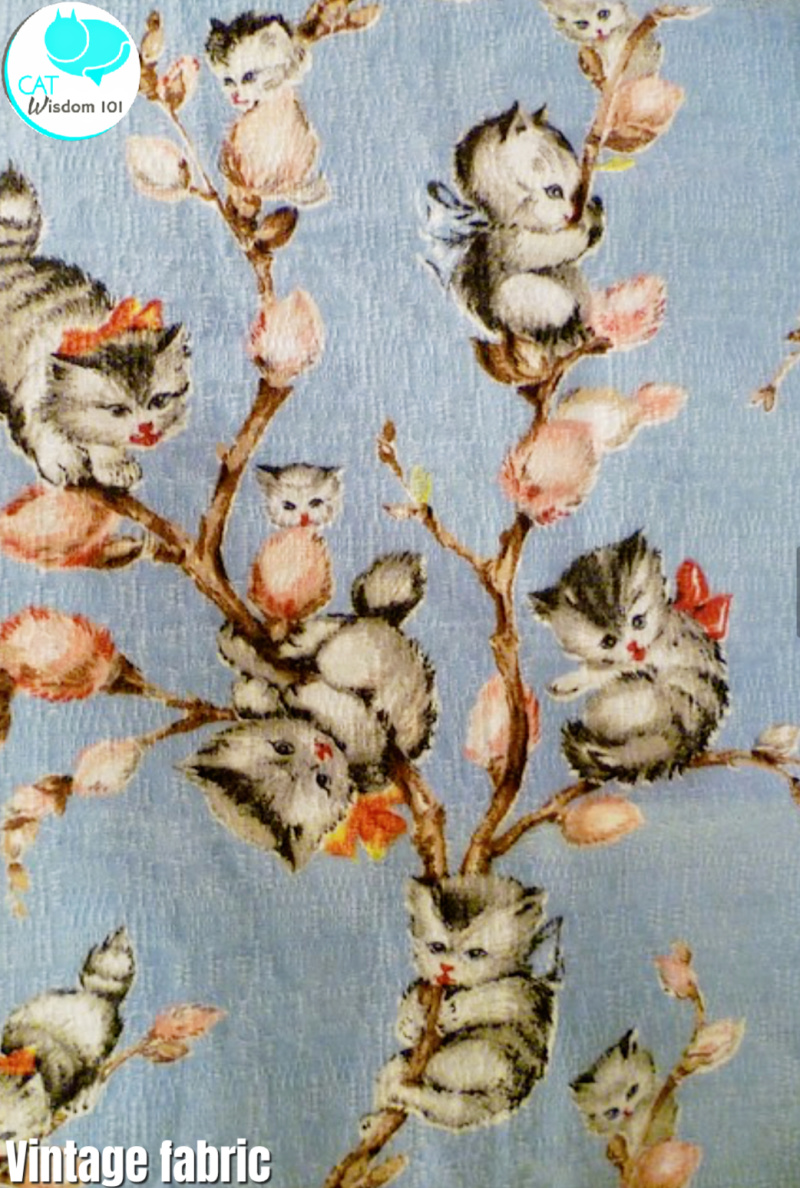
European Folklore
In parts of Europe like Germany, France, and Britain, there are old tales that pussy willows emerged from cats scratching, pawing or swatting at willow branches. The belief was that when cats shed fur in the spring and brushed up against willow trees, their scratching motions and loose fur caused the soft, fuzzy willow buds to appear on the branches.
This folk idea likened the silvery-gray color and texture of emerging pussy willows to shed cat fur clinging to willow twigs. There are variations where the willows sprang from cats sleeping under the tree.
England and U.K.:
In many regions, it was believed that bringing fresh cut pussy willow branches into the home would cause any cats living there to excessively shed and molt their fur. To prevent this, some would gently strike or brush their cat’s coat with a pussy willow branch when first bringing it indoors as a counter-measure.
On a practical note: Brushing a cat with pussy willow branches would pick up some lint or stray hairs but no substitute for a real brush.
- English folklore said burning withered, dried pussy willow branches would release a smoldering smoke that could rid a home of fleas tormenting the household cats. The ashes left behind were thought to repel fleas and other pests when sprinkled around.
German/Dutch Beliefs:
In Germanic pagan traditions pre-dating Christianity, the willow tree held symbolic meaning tied to the goddess Freya (or Freyja). As a fertility goddess, Freya’s mythology included associations with cats.
German legend said cutting a willow branch while invoking Freya’s name during certain phases of the moon would aid in the safe birthing of kittens if the branch was placed in a queen cat’s nesting box.
Willow branches were also used in rituals to honor Freyja as a protector of human babies, crops and animals like cats from harm. Bundles of pussy willows decorated the beds of expectant mothers and barn cribs for birthing.
When Christianity spread through the Germanic regions, the pagan willow traditions amalgamated with the new religious customs. Willow branches became the accepted substitute for palm fronds on Palm Sunday celebrations.(Practical choice since palms trees aren’t native to Germany).
This included the practice of gently striking humans and animals like cats with the willow branches as a symbolic purification and blessing for health.
Decorated willow branches were hung over stables and barn doors to safeguard the residence within, including feline mousers. Drying the fuzzy buds from the pussy willow branches was believed to create a natural flea-deterrent and de-worming remedy that could be worked into the bedding of household cats.
Even today, some traditional German households may incorporate pussywillows into spring cleaning rituals, using the branches to symbolically “brush away” any fleas, illnesses or streaks of bad luck impacting their beloved house cats.
- Traditions held that giving a cat a fresh pussy willow branch to play with, chew on, or rub against would help prevent diseases and promote good overall health and wellbeing for the feline. The branches were seen as having protective qualities.
- There were myths that pussy willows grew particularly vibrant and lush near homes with several resident cats. The trees were said to thrive off the presence of cats, with the furry “pussy” buds symbolic of feline fertility.
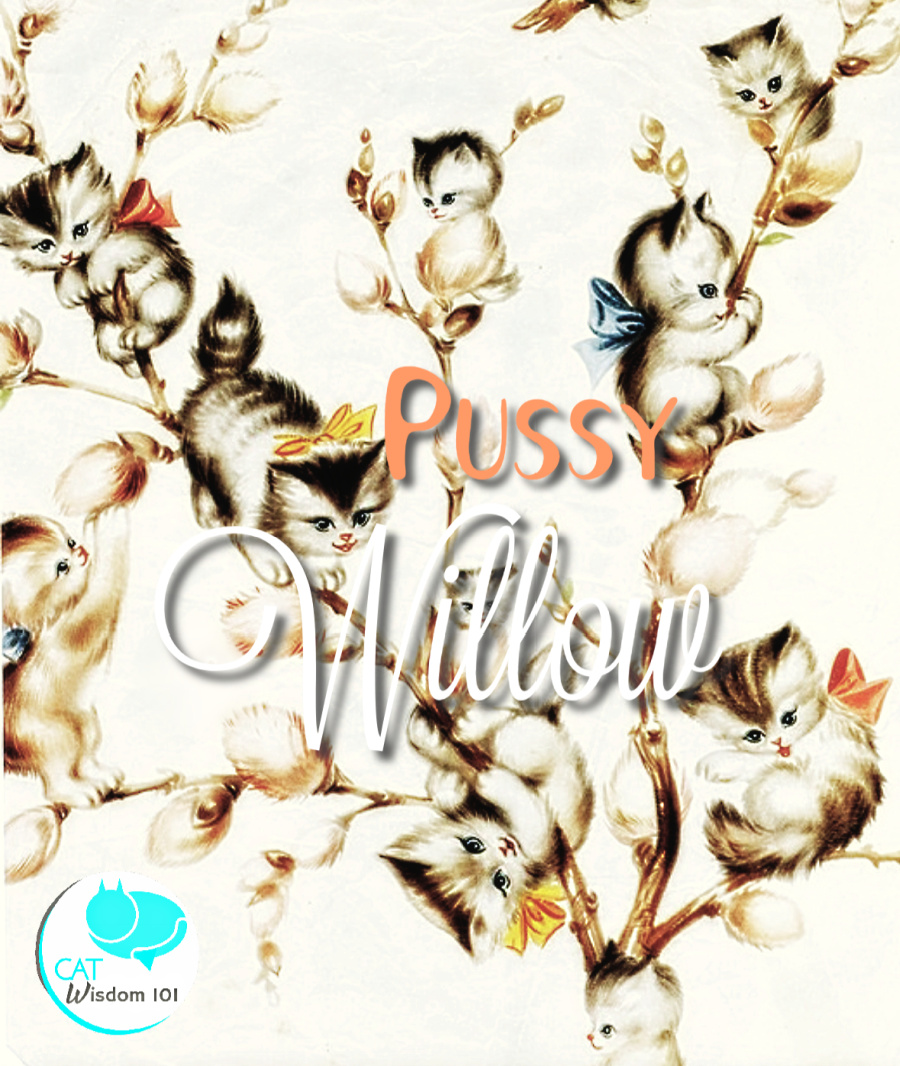
Russian Folklore and Beliefs:
In Russian Orthodox Christianity, the branchy pussy willows with their soft furry buds are known as “verba” or “verbnya.” They are intricately tied to the celebration of the Feast of the Entry of Christ into Jerusalem, which falls on Palm Sunday.
Since ancient times, Russians would gather pussy willow branches to form bouquets and decorations for this holy feast day in lieu of palm fronds. The bundles were spread through churches and homes as symbols of Christ’s entry into Jerusalem.
On the Eve of Palm Sunday, it was customary for Russian families to gently strike each other’s backs with the soft pussy willow branches as a ritual purification and blessing. This tradition extended to lightly tapping household pets like cats with the willow for purported health benefits.
For the Feast Day of St. Blaise on February 11th, Russians would weave intricate pussy willow crowns or wreaths to adorn the saint’s icons in churches. St. Blaise is the patron saint of cattle, domesticated animals and household pets – including cats.
Using the willow branches honored his guardianship over felines. There were folk beliefs that keeping dried pussy willow branches in the home after these feast days would protect any resident cats from disease, aid their hunting prowess, and ensure an ample supply of vitamin-rich catnip and grasses for them.
Some ethnic Russians still observe these customs today, continuing the long associations between the venerated pussy willow plant and the health and fertility of household cats.
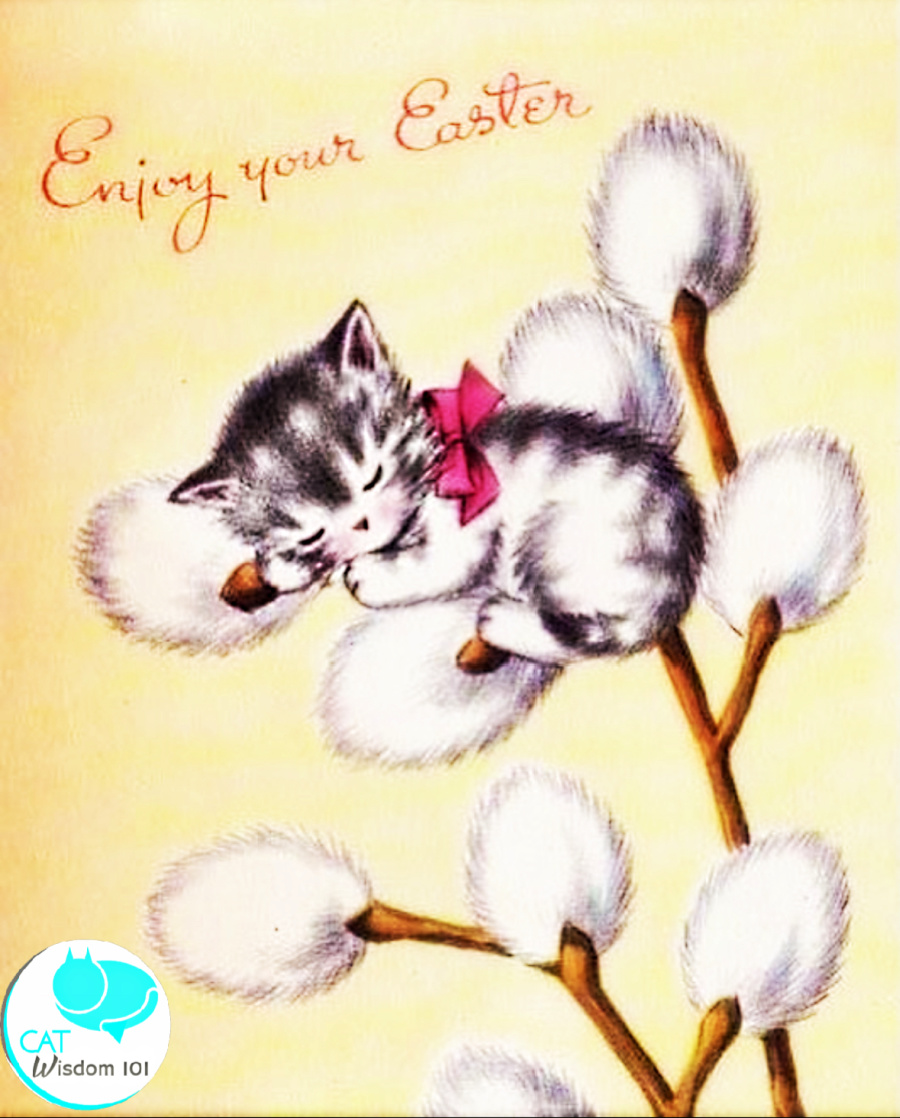
Swedish Folklore:
In parts of Scandinavia like Sweden, there are folktales that pussy willows grew from the tails of kittens that had gotten frozen to death outside in winter snows. When spring came, their tails sprouted into the furry catkins on the willow branches they were clinging to.
Some Swedish legends say a nature spirit took pity on the frozen kittens and allowed new life to emerge from their tails in the form of the soft buds. Other tales contend the kittens were able to enter a never-ending slumber where their souls took root as pussy willows.
Finnish Traditions:
In Finland, there is an ancient pre-Christian tradition called palmonvihtomiesten about women dressing up as “Easter witches” or wizards on Palm Sunday. They would go door-to-door carrying large ornamental pussy willow branches decorated with feathers, crepe paper, etc. The witches would “trick or treat” waving the branches expecting treats.
The willow branches were used to gently strike or “whip” family members as a ritual for good fortune and health in the coming year, similar to some Germanic traditions mentioned earlier.
So while the Finnish Easter witches with decorated willows and the Russian Palm Sunday customs emerged from different cultural roots, the underlying use of the branches in early spring for rituals promoting health/fertility does provide a loose conceptual connection between the two traditions.
As a Finn, I’d like to note: Finland was ruled by Russia from 1809 to 1917 which may account for some influences.

Here are some more superstitions and folklore linking pussy willows to cats.
Fertility/Birthing Rituals:
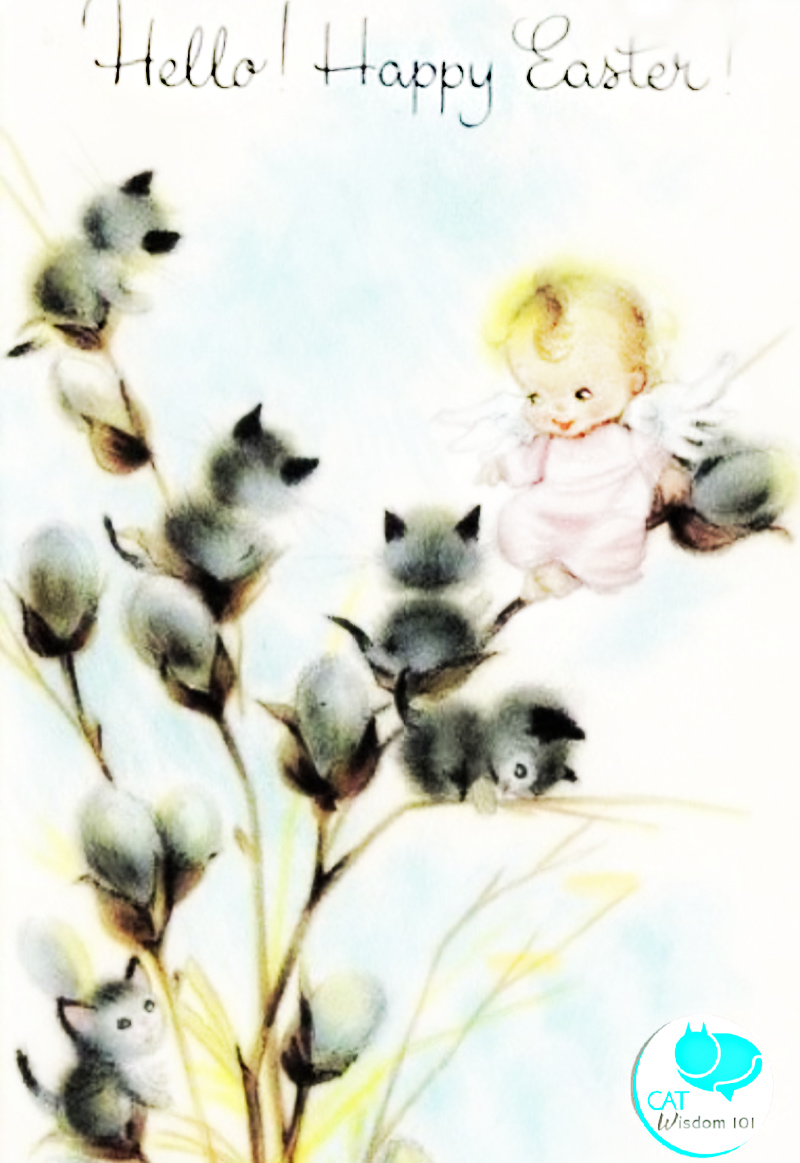
- In parts of Germany and Poland, it was considered good luck to have a pregnant woman gently struck with pussy willow branches before giving birth. This was believed to ensure a safe delivery.
- The soft furry buds of pussy willows were also associated with fertility. Some women would sleep with the branches under their mattress or pillow when trying to conceive a child.
- For cats, midwives would sometimes line the birthing nest with pussy willow branches to promote an easy labor for the cat mother.
Warding Off Evil:
- Hanging a pussy willow branch over a doorway or across a window was thought to prevent evil spirits and ill fortune from entering the home and threatening residential cats.
- In the Balkans, pussy willow whips were used to symbolically “beat away” any curses, jinxes or misfortune that could impact the family’s cats.

Enhancing Hunting Prowess:
- Some English folklore claims that weaving a pussy willow branch into a cat’s collar would sharpen its hunting instincts and skills at catching mice or birds.
- Farmers might place willow branches around barn entrances to draw mice toward the area where their working farm cats could hunt them.
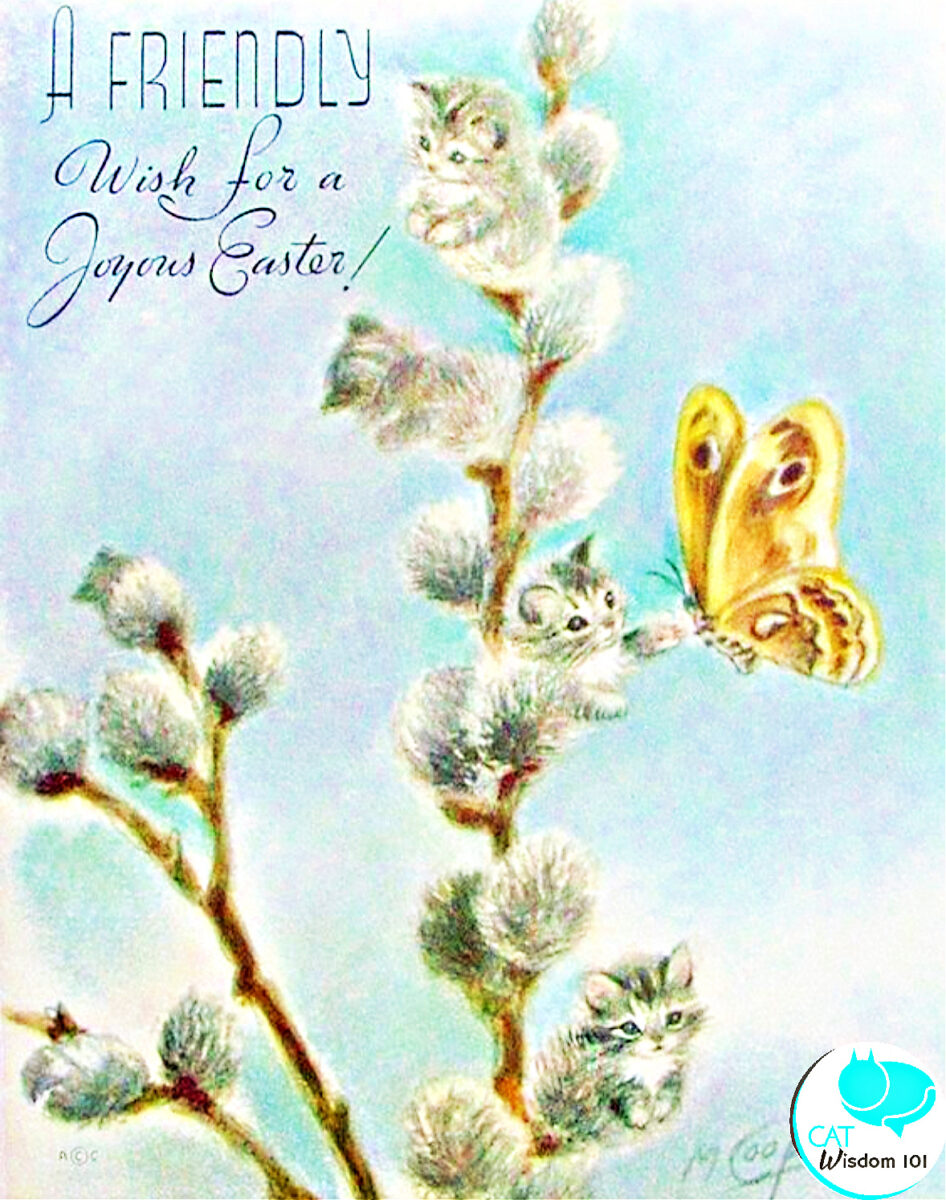
Love/Romance:
- Hitting a lover with a pussy willow branch was an old Celtic folk ritual said to ensure fidelity and lasting devotion in the relationship.
- Unmarried women were sometimes instructed to sleep with willow branches under their pillow on certain holidays to dream of their future husband or romantic partner.
- Aspects of these love rituals may have extended to wishing for fertile, loved cats as well in some cases.
So covering various domains like birth, protection, enhanced abilities and romance – the soft, fuzzy pussy willow emerged with magical associations for human and feline flourishing in European folklore traditions. It’s no wonder artists have embraced depicting cats with pussy willows and morphing into them.

I hope this gives you a better understanding of the pussywillow and kitty connection.
In springtime, a curious sight,
Kittens frolic, their hearts light.
With a whisker twitch so mellow,
They turn into willows, oh so yellow,
Easter magic, a pure delight!
It’s Otto’s first Easter with us. He was sleeping so sweetly, I wondered what he was dreaming about.

Happy Easter to all who celebrate!

Lots of eggcellent and furry wishes,
Layla, Odin and Otto
P.S. If you love vintage Easter cat art as much as I do, there are lots to peruse in the archives like Purrfect Easter Cat Cards





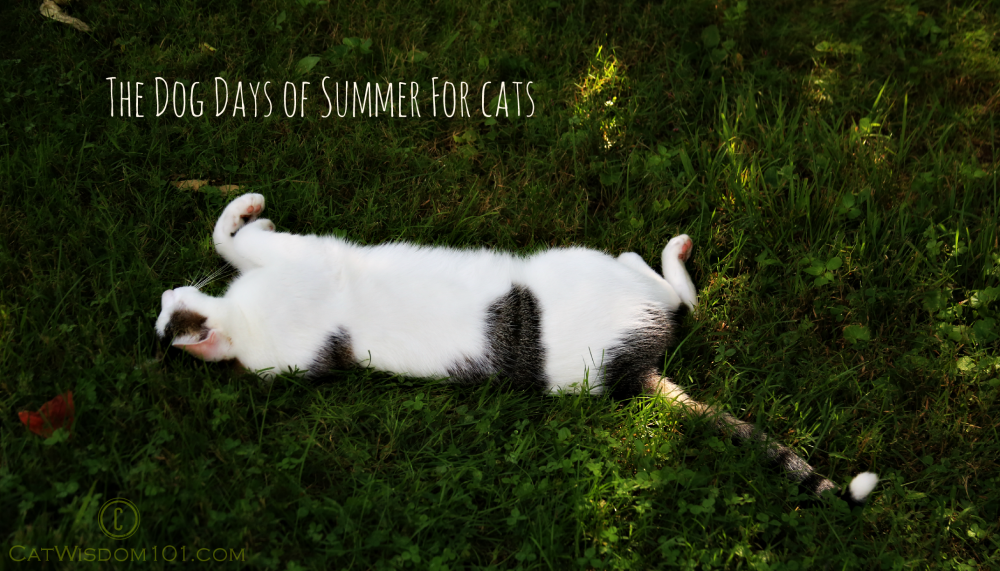
17 Comments
Cindy Hall
I really enjoyed this Easter folklore! When I was around five years old, I loved to pick pussy willows and keep them until they were dying. I still take walks on the hill behind our home, and I still find pussy willows. Thank you!
Nancy West
What a delightful post! Layla, this is so special! I have such fond childhood memories of my mother bringing pussy willows home in the spring. I’m going to buy some today!
Thank you!!
Athena and Marie
Great post. The vintage art is amazing!
meowmeowmans
We have always loved pussywillows, but never knew all these cool things about them. Happy Easter, sweet friends!
Lizabeth Setliff
Happy Easter
Those are the most darling portraits ever.
Pawsitively Love them!!
Meowmazing 🙏🏼😻🐇🩷🐰
Layla Morgan Wilde
Thanks so much and lots of purrfect Easter love to you 🐈⬛💐
Melissa & Mudpie
This is so interesting! I love pussy willows 🙂
Memories of Eric and Flynn
There is a lot of interesting information about the legends connected to Pussy Willow. We have several trees in the hedges around our fields.
Layla
You’re lucky! We used to have lots at our old house but not here. Happy Easter💐🐇
Ellen J Pilch
Great post. We love pussy willows. We have 3 trees and every spring we cut many, make arrangements and give them to friends and family. I love all the pussy willow art too. XO
Layla
Lucky you! They are so beautiful. Try brushing the cats and see what happens.
messymimi's meanderings
You’ve covered a lot of ground here, I had no idea there were so many legends about pussy willow.
The Easter cards are a delight.
Thank you for linking up with Feline Friday!
Layla
Thanks, it’s ways in depth here 🙀
Brian's Home ~ Forever
Love those pussywillows, they are so darn cool. Happy Easter from all of us!
Layla
Happy Easter to the entire family 🐈⬛💕🌸
Amy Harlib
I have always loved pussy willows and their association with cats.
It is a delight find this so prevalent in folklore all over Europe and N. America for centuries if not millenia!
Joyous Easter and Passover!
Layla
Thanks and me too! Passover is late this year. I’ll probably repost an old one!